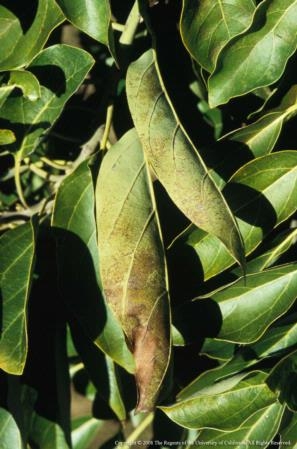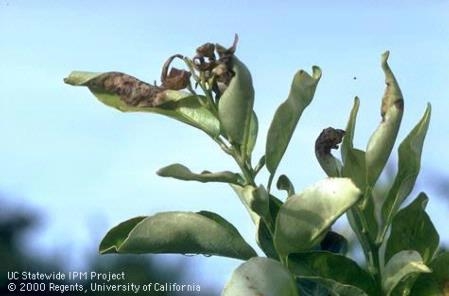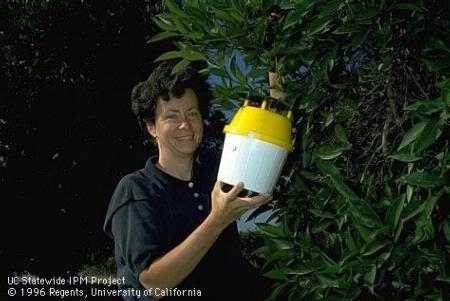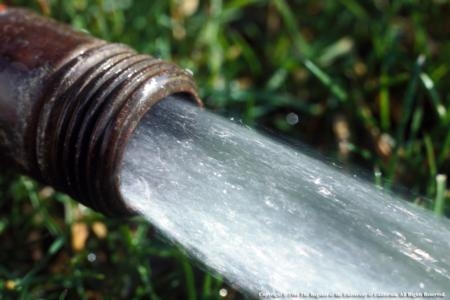- Posted By: Chris M. Webb
- Written by: Ben Faber
A Frost Primer
Definitions:
Dry-bulb temperature: the temperature of the air as measured with a thermometer.
Wet-bulb temperature: the temperature that the tree will likely sense due to evaporative cooling of the leaves.
Dew point temperature: the air temperature required for condensation (dew or frost) to occur. This is an indication of the amount of humidity in the air. The higher the dew point, the lower the rate of cooling. As dew forms, the water releases heat (heat of condensation), and the temperature levels out.
A high dew point -- above 40 degrees
A moderate dew point -- between 25 - 40 degrees
A low dew point -- between 10 - 25 degrees.
"Cold night": any night at or below 32 degrees F.
"Key stations": weather stations with at least a ma/min thermometer and a thermograph in a white box facing north.
Temperature inversion: an atmospheric layer in which temperature increases with altitude. High temperatures during the day promote the formation of the inversion.
"Temperature ceiling": height to which heated air rises during orchard heating. The lower the ceiling, the stronger the inversion and a greater amount of heat can be obtained from wind machines and orchard heating.
Radiation freeze (frost): local cooling due to rapid heat loss from plant and soil surfaces under clear skies and light or no wind conditions. Daytime temperatures are usually in the 45-55 degree range which causes the formation of a nighttime inversion. Any significant breeze will cause temperatures to rise due to mixing of the inversion.
Advective freeze: cooling of a wide area by dry polar air. Typically the temperature is at or below 32 degrees for 2 or more days. The temperature ceiling is high or non-existent. This was what we got in December 1990.
1 gram of water = 1 calorie/degree of temperature change (°C)
1 gram of water = 79 calories released on freezing
1 gram of water = 607 calories consumed when evaporated
Gauging Wind Speed
|
Effect of air movement |
Wind force (mph) |
Terms used in forecasts |
|
Calm; smoke rises vertically |
less than 1 |
|
|
Wind direction shown by smoke drift |
1 - 3 |
light |
|
Wind felt on face, leaves rustle |
4 - 7 |
|
|
Leaves and small twigs in constant motion |
8 - 12 |
gentle |
|
Raises dust and loose paper; small branches move |
13 - 18 |
moderate |
|
Small trees in leaf begin to sway |
19 - 24 |
fresh |
|
Large branches in motion |
25 - 31 |
|
|
Whole trees in motion |
32 - 38 |
strong |
|
Breaks twigs and weak branches |
39 - 54 |
gale |

- Posted By: Chris M. Webb
- Written by: Ben Faber
How Frosts and Freezes Occur
Before considering the methods of frost protection, one should understand the conditions under which low temperatures occur. To differentiate between the two major sources of the cold, the terms local radiation frost and freeze are used.
Local radiation frosts are caused by a cooling of the objects on the earth's surface during the night. This loss of heat from the foliage and soil is called radiation. Heat accumulated from sunshine during the day is radiated to the sky during the night. The cooled objects chill the surrounding air and usually the coldest zone is near the ground surface. Air temperatures are warmer as one goes higher until a height is reached where they area art a maximum for that locations. This is called the ceiling. The temperature and height of the ceiling is different for each plane and situation.
When the ceiling is low, warm air is nearer the ground than when the ceiling is high/ This phenomenon, occurring frequently in Southern California, is called temperature inversion and accounts for this areas; ability to protect its orchards.
Colder air settles near the ground and then moves (flows) down the slope to still lower ground resulting in what is called the drift.
Terrain features and winds influence its direction and velocity. A strong drift maintains air temperatures higher than those existing when little or no drift is present
The other type of freezing weather occurs when a large mass of cold air moves in from the north. Fortunately, these freezes have not occurred frequently, about every 10 years. Under freeze conditions, temperatures usually go below those experienced during local radiation frosts. When this cold air moves in, high ground is no warmer than lower ground and there is little or no ceiling. Orchard protection at such times is difficult.
General Cultural Practices
Three to four degrees F of higher temperatures can mean the difference between a bad burn and death of a tree. The following practices can help protect your orchard from frost damage; they all have in common some method of retaining heat in the orchard.
During the day, an orchard soil acts as a reservoir for heat absorbed from the sun. Some of this heat returns back into the atmosphere during the day and at night (reradiation), warming the orchard. Moist soils will store more heat and are better heat conductors than dry ones, and a compacted soil - one that forms a firm surface - is a better conductor of heat than a soil that has been recently cultivated. Therefore, when there is danger of frost, do not cultivate your orchard soil, but do keep it moist to a depth of at least one foot.
The insulating effect of weeds, sod and leaf litter between the rows reduces soil absorption of heat during the day and reduces reradiation. In an experiment, an orchard that was weed-free with a compacted soil showed 3.8° F more warmth than an orchard with sod. The same experiment demonstrated that an orchard with rain compacted soil was warmer than one that had been recently cultivated. If you have a ground cover, mow as short as possible to minimize the insulating effect.
The size of the tree canopy in many ways determines the amount of reradiated heat that is captured by the trees. A large, dense canopy can intercept more heat leaving the orchard than a small, sparse one. A healthy tree has been shown to have a higher canopy temperature than a sparsely-foliated tree. For example, lemon trees with sieve-tube necrosis are frequently more frost-damaged than healthy ones, partly because of the sparseness of the foliage. Proper pest and disease control, irrigation and fertilization are all important in maintaining a healthy tree more resistant to frost damage.
A most important factor in determining how damaging a frost may be is the time of year which it occurs - early or late winter. If the frost comes early, before temperatures have a chance to drop gradually, trees have not had time to acclimate themselves, and the damage can be severe. If, however the frost hits later in the season (after a period of gradual temperature decline), trees can develop a cold hardiness and better tolerate the cold weather. To this end, late applications of nitrogen that cause excessive growth may delay this acclimation , thereby further reducing the tree's cold tolerance.
In most cases, frost protection can be improved by improving air drainage. Brush, tall weeds and trees can impede the movement of cold air out of an orchard. Remove these obstacles (or at least mow the weeds or prune up windbreaks), creating channels for air movement.
Managing Irrigation Water for Tree Protection
Irrigation water releases two types of heat when applied during a frosty night: the heat released by going from the water temperature at the nozzle down to 32° F (0° C), and another type called the heat of fusion, which is how most of the warming energy is released. This is the energy that is obtained by water going from a liquid to a solid state. For every degree of temperature drop (Celsius), there is one calorie of heat released per gram of water. A gram of water with a nozzle-exiting temperature of 65°F will release about 18 calories of heat when it cools to 32°F, but in changing from liquid to ice, 79 calories are released. The more ice that is made, the more heat is released. This heat helps raise the temperature of the orchard.
In furrow irrigation it is best to place the furrows as close to the dripline as possible and make the furrows as wide as possible to increase the transfer of heat into the air. With sprinklers, the more output the better. At Lake Alfred, Florida, the guidelines call for at least 20 gph sprinklers, with lower rates giving less effect. If you do not have the capacity to irrigate your entire orchard, it is advisable to choose one area and protect it, rather than stopping in the middle of the night to irrigate another area. This is because the resultant evaporative cooling will take 607 calories per gram of water, and this heat loss comes at the expense of the leaf. Therefore, an area where the water has been turned off prematurely will rapidly cool.
The rate of cooling is related to the dewpoint. A high dewpoint indicates moist air, and a low dewpoint relatively dry air. The drier the air, the more rapid the cooling. When temperatures are low with extremely dry air conditions, irrigation can be a hazard to trees. If the predicted dewpoint is well below (at least more than 5 °F) the predicted minimum temperature, sprinklers can cause excessive evaporative cooling. With evaporative cooling, orchards with running water can actually be cooler than dry orchards. Therefore, if trees are sprinkled and ice forms, in order to protect the trees, the sprinklers should continue in operation until the ice begins to melt. To be certain, sprinklers can continue until the ice is completely melted.
Use of Wind Machines
In most situations, wind machines can be both effective and economical in providing protection; however, in some situations, as we found in the advective freeze (cold polar winds) of 1990, they can exacerbate the situation. The dry cold air drawn in by the machines will intensify the cold damage.
The San Joaquin Valley and Southern California more commonly have radiation frosts (heat loss under conditions of clear skies and light wind conditions) which commonly have a temperature inversion. For a machine to do its job properly, this temperature inversion is needed so that warmer temperatures at higher elevation can be mixed with cold air near the ground.
The number, power requirement and area protected vary with terrain and manufacturer's brand. Generally 7 to 10 brake horsepower are required per acre, more in cold spots, less if there is a slope. They should be started before temperatures drop below 35°F, since it is difficult for a wind machine to warm an orchard that has dropped below this critical temperature.
Ice-nucleating Bacteria
For some years, it has been known that bacteria residing on cold-sensitive plants initiate ice formation. The ice formed in or on the plants spreads rapidly, causing mechanical injury. Copper-containing sprays that are applied 10 days before cold weather, kill off these bacteria and allow enough time for their decomposition. By controlling the ice-nucleating bacteria (INB), tests have shown temperatures may drop 2-4°F below critical levels without plants showing damage.

- Author: Chris M. Webb
A new volume of Topics in Subtropics is now available.
This newsletter is a collaborate effort of UCCE Farm Advisors throughout the state. Topics in this issue include:
- Organic Herbicides: Do they work? – An interesting research summary on organic herbicide products currently available. Suggestions for maximizing results are included.
- Snake Oil: Horticultural Myths and Legends – Practical tips for avoiding products that do not provide benefit or can possibly cause harm.
- Success Story Before There is a Problem – Ben Faber describes a common pest in Turkey that causes much damage to a wide range of plants, including citrus. Tropinota hirta Poda (Coleoptera, Scarabaeidae, Cetoniinae) feeds on flowers and reproductive plant parts, resulting in no fruit formation. While this beetle is has not yet been found in the United States, knowledge of potential method for control is already stateside.
To access this addition, as well as previous additions, of Topics in Subtropics please visit this page of our website.

- Author: Chris M. Webb
One of our regular blog readers submitted a question about using chlorinated city water when watering plants. He noted that watering plants with stored rain water promotes growth in comparison to chlorinated water. Also mentioned was the potential for chlorinated water to kill beneficial organisms in the soil that nourish plants.
Ben Faber, a UCCE scientist specializing in: soil; plant; water; and nutrient relationships, says that chlorinated water can be a problem. For those wishing to water plants with chlorine-free water, simply let the water sit for a few hours to allow the chlorine gas to leave the water.
Gravity-flow drip systems, like the one shown in this article may be useful for those who appreciate the benefits of drip line irrigation.
Not all municipal water sources use chlorine to treat water. Check with your water supplier first to find out what is used to treat water in your community. Many cities are using chloramine which is more stable than chlorine gas.

- Author: Chris M. Webb
Curious as to when to provide care to your avocado trees throughout the year? UC Cooperative Extension Advisor, Ben Faber has included this information for growers and gardeners on this page our website. These recommendations are specifically for our local climate and conditions.
For more avocado related topics, please see our previous blog posts and website.




